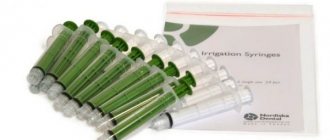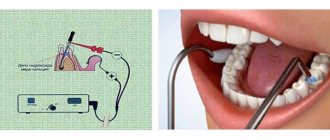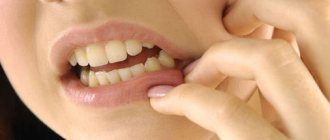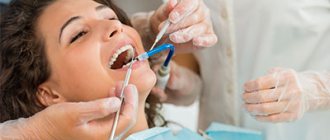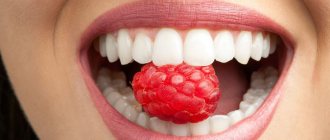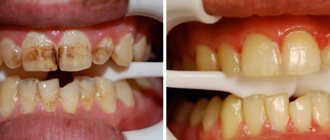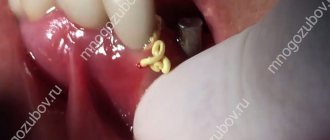Caries is a common dental disease that destroys the hard tissues of teeth. According to statistics, it affects about 95-98% of the population of economically developed countries. In the treatment of caries, medicinal pads can be used. In what cases and for what they are used, we will tell you in this article.
In this article
- What is a therapeutic pad in dentistry?
- In what cases is a lining used for caries?
- Why are medicinal pads used in the treatment of deep caries?
- How is a therapeutic napkin installed for deep caries?
- Materials of therapeutic pads
- How do combined pastes work?
- Pros and cons of using medicinal pads in dentistry
Therapeutic pad in dentistry
Therapeutic pads in dentistry are used to relieve inflammation, prevent its development, and stimulate restoration processes. The following requirements apply to them:
- anti-inflammatory and odontotropic (formation of healthy tooth cells) effects
- seal dentin tightly
- high adhesion with temporary and permanent fillings, insulating gasket
- inertness to the pulp (do not irritate)
- similar properties to permanent fillings (same shrinkage, resistance to temperatures, external environment)
Therapeutic pads in dentistry are used when processes in the pulp are reversible.
Such cases include: deep caries, acute focal pulpitis with a conservative treatment method, accidental opening of the pulp with subsequent preservation. As you noticed, purulent and chronic forms are not listed here. By that time, irreversible changes occur in the pulp: cell atrophy, replacement of nervous tissue with connective tissue. It will not be possible to restore the previous functions, only to transform the chronic process into a sluggish one with a rare number of exacerbations. Do not forget about additional factors: the age of the patient (up to 40 years), ease of access to the filling cavity, low EDI values in dentistry, the absence of serious illnesses in the background (heart attack, pyelonephritis, pneumonia, etc.). Treatment is carried out in 2 stages:
- Impact on pathogenic microflora, relieving inflammation. “Strong” drugs are used for a couple of days. Used for occasional or focal pulpitis
- Stimulation of reparative processes. They act for a long time and do not decompose under the influence of pathological microflora. Tactics used for caries
What are they needed for?
Filling materials, to varying degrees, irritate the dental pulp. For multicomponent materials, the matrix can be toxic. But this does not mean that all dental treatment products contain irritating properties. Isolating pads in dentistry are used not only to remove the negative impact on loose connective tissue, but also for:
- preventing the ingress of toxins;
- protection from filling material, which can have a destructive effect on tooth tissue;
- reducing the risk of microcracks forming during shrinkage of the filling.
What are the requirements for gaskets? Here are just a few of them:
- Long-term protection of dentin from chemical attack
- Protection of enamel from high and low temperatures.
- Protection from the aggressive effects of saliva.
- Stronger adhesion to the tooth compared to a filling.
- Does not affect the pulp.
- Easy to install.
There are two options for isolating gaskets in dentistry:
- The first option is the base one (a layer of more than one millimeter). It protects the pulp from external irritants, maintains the shape of the cavity, and is also an integral part of more expensive fillings.
- The second option is thin-layer. Does not fully protect against external irritations. Provides stronger adhesion between filling and tooth.
There are several groups of gaskets.
Application area
The main purpose of any insulating gasket is to eliminate the impact of the filling material on the pulp. It also isolates the nerve of the tooth from toxins, protects against the occurrence of microcracks and marginal gaps that can form after the filling shrinks.
Requirements for insulating gaskets
The insulating gasket must:
- Protect dentin from chemical and temperature irritants;
- Easy to install;
- Withstand the most aggressive effects of saliva if the integrity of the filling is compromised;
- Withstand the maximum possible chewing load;
- Be bonded to the tooth more strongly than to the filling;
- Do not have a negative effect on the dental pulp.
Also, the insulating lining should not change the natural color of the tooth enamel.
Indications and contraindications
Medical pads are necessary in the following cases:
- deep caries (close to the pulp);
- focal pulpitis;
- if there is an accidental opening of the pulp.
Quite a lot of research has been done on the tolerability of therapeutic pads. It has been proven that therapeutic pads do not cause allergic reactions or pulp irritation.
Benefits of therapeutic pads
Therapeutic pads have both anti-inflammatory and regenerating, necrotizing and analgesic effects. The gasket material has good ductility and hardens quickly. Such a lining significantly reduces the risk of developing secondary caries and the formation of microcracks.
Flaws
It should be noted that therapeutic pads, for all their advantages and positive effects on the pulp during inflammatory processes, also have quite serious disadvantages, which, if used incorrectly, can lead to a number of problems:
- Therapeutic pads do not have the property of adhesion to dentin, which leads to weakening of the adhesion of the filling to various dental tissues;
- The healing materials of the pad gradually dissolve, dissolve, and this creates conditions for further infection of tissues;
- If the materials of the treatment lining get on the walls of the cavity formed during the treatment process, it causes microbes to enter the tooth, which will lead to secondary caries.
That is why the use of therapeutic pads for inflammation in the teeth should be trusted only to a responsible specialist who will not make mistakes and ultimately guarantees the quality of treatment and installation of a filling on the tooth.
Basic principles of therapeutic pads
The therapeutic pad can be:
- non-hardening;
- fast-hardening;
- long-hardening.
The composition of the base material is polymer, aqueous, oil or monomer. Dentists use either ready-made medicinal pads or prepare them themselves.
Classification of medicinal pads in dentistry
Based on calcium hydroxide
Ca(OH)₂ is an alkali with a high pH value, decomposes into calcium and hydroxide ions. Dentin next to the pulp has increased permeability and calcium hydroxide preparations reach the site of action where replacement dentin is produced. Because of this, pathogenic microflora does not penetrate the pulp. Loses its positive properties upon prolonged contact with air. Presented in 4 forms:
- aqueous suspension
- varnishes
- chemically cured cements
- light-curing polymers
Aqueous suspension - pure calcium hydroxide in water or saline. solution. For contrast in the pictures, barium sulfate is added to the composition. The drug is applied to the bottom of the cavity and dried with a gentle stream. The thin layer is covered with a temporary filling. After a month and a half, the hydroxide, under the influence of liquid, penetrates into the pulp. Therefore, the bandage is changed every 3-6 weeks. Mineral cements cannot be used as a temporary filling due to the chemical interaction between substances (phosphoric acid and hydroxide). Used as a strong remedy for a short period, as an accidental opening of the pulp. Preparations: Calcipulp, Calasept, Calcium Hydroxide.
Based varnishes – contain calcium hydroxide, resin, zinc oxide and solvent. The varnish is applied with a cotton swab or brush and dried with a gentle stream. Despite the good insulating properties, there is no therapeutic effect, so the product is rarely used. Drug: Contrasil.
Chemically curing cements harden after mixing two pastes (ether and hydroxide). They do not change color, do not come into contact with composites, and are malleable. However, they do not chemically bind to dentin, are soluble in alcohol, and have different degrees of compression with cements. Therefore, the material is applied in a thin layer. As a gasket, they are applied pointwise.
Light-curing polymers. Increased strength, easy to use, but not in demand due to the likelihood of burning the pulp and low therapeutic effects.
To summarize, the most effective therapeutic pads in dentistry are suspensions and chemically cured cements.
Zinc – eugenol cements
Contains eugenol - a natural antiseptic. The cement reaches its final hardness in 10 hours. Not used with composites due to the action of eugenol. Preparations: Cavitec, Kalsogen Plus.
Combined products
The paste is prepared by a doctor, depending on the availability of ingredients, the doctor’s experience, and the clinical picture.
- Odontotropic drugs stimulate the formation of replacement dentin (fluorides, calcium glycerophosphate, collagen, hydroxyapatites)
- Anti-inflammatory drugs (prednisolone, hydrocortisone) and NSAIDs (salicylates)
- Antiseptics (chlorhexedine and metronidazole)
- Enzymes (proteolytic)
- Other products (EDTA, novocaine, dimexide, vitamin solutions)
Preparations: Dycal, Life, Pulpomixine, Calcipulpe.
Dycal, Life - cements that harden by the interaction of two pastes. They are in demand.
Pulpomixine is a mixture of antibiotics and corticosteroids. Normalizes blood circulation, suppresses pathogenic microflora. “First aid kit” for acute processes in the pulp. Does not help form dentin, used within a couple of days. After removal, odontotropic preparations are applied.
What brands of products are available for sale?
There are three manufacturers of retaining spacers for dentures on the market. As a rule, there are no problems with where to buy products - they are available for sale in pharmacies, online stores in the relevant field, and you can also purchase them on the website of the manufacturer or representatives.
- Protefix (“Protefix”): characterized by strong adhesion, good shock-absorbing properties, and elasticity. The fixing effect lasts up to 8 hours. Soft pads "Protefix" are excellent for use in cases of abnormalities of the jaw bone tissue. They require preliminary wetting and are placed on a damp prosthesis. The cost of products ranges from 270 to 500 rubles for 30 pieces,
- Fittydent (“Fittydent”): pads from this manufacturer keep the denture in the mouth for 12 hours, regardless of the amount of saliva, the need for rinsing and other factors. They have increased softness, therefore they are indicated primarily for people prone to inflammatory processes of the mucous membrane. They do their job perfectly even with narrow lower dentures. The pads are placed on the dry prosthesis. The price of products on average ranges from 320 to 550 rubles for 15 pieces,
- Denture Fixing Tape: available as individual strips or as a continuous sheet rolled into a roll. This makes it possible to provide the most suitable shape and size. The thickness of the gaskets does not exceed 1/2 mm. Fixation does not depend on the dryness of the surface of the prosthesis, but requires preliminary targeted application of a fixing agent (for example, Corega cream) in the front part of the structure and along the edges. The price of products ranges from 320 to 530 rubles.
Therapeutic and insulating pads
Therapeutic pads .
In cases where the bottom of the carious cavity is close to the pulp, even the most gentle preparation has an adverse effect on the dental pulp. In these cases, the bottom of the cavity is covered with a medical pad before applying an insulating pad and before filling the teeth. Therapeutic pads are preparations based on calcium hydroxide. It is believed that due to the pronounced alkaline reaction of the drug, the blood circulation of the pulp is normalized and intensive deposition of replacement dentin occurs. Recent studies have shown that not all problems with therapeutic pads have been solved. The use of medicinal dams in small cavities weakens the adhesion of the filling to the dental tissues (therapeutic dams do not have adhesion to dentin). If the medical lining remains not only on the bottom, but also on the walls of the cavity, then it can become a path for the penetration of microbes and the development of secondary caries. The material of the treatment pad may gradually dissolve and open the way for infection. Particularly problematic is the need to use therapeutic and insulating pads under composite materials. Manufacturers of bonding systems often propose to abandon spacers and replace them with modern adhesive systems. However, it is not denied that the use of calcium hydroxide-based preparations reduces the potential danger of infection under the filling. Examples of materials for therapeutic pads include the following:
Deikal
(Dycal). Durable self-curing material, paste-catalyst system. Contains 25% calcium hydroxide. Compatible with all filling materials.
Life
(Life). Therapeutic pad based on calcium hydroxide.
Calcipulp
(Calcipulpe). Paste based on calcium hydroxide. At the bottom of the cavity, it neutralizes acids released during the hardening of the filling material. It is used as a therapeutic lining for deep caries, and also eliminates the increased sensitivity of teeth treated for an orthopedic crown.
Insulating gaskets . It is believed that almost all permanent filling materials can have an irritating effect on the dental pulp (for example, composites due to the toxicity of the organic matrix). There is, however, evidence of the absence of chemical irritation of the pulp by widely used filling materials. Isolating gaskets are used not only to protect the pulp from the irritating effect of the permanent filling material, but also to isolate the dental pulp from toxins, reversely isolate the filling material from the influence of dental lymph, improve the adhesion of the filling (reducing the likelihood of the formation of microcracks and marginal gaps due to shrinkage of the permanent filling material ). Isolating pads are used to cover medicated pads and root fillers. As with therapeutic pads, the need to use isolating pads when adhesive systems are available is widely debated. The materials of insulating gaskets are subject to very stringent requirements: lack of chemical toxicity, mechanical strength, impermeability to acids and monomers (released components of permanent fillings), low thermal conductivity, good adhesion, coefficient of thermal expansion close to the hard tissues of the tooth. Examples of modern materials for insulating gaskets include the following.
Ionosil
(Ionoseal) is a light-curing glass ionomer cement. It is resistant to acids, has good adhesion to dentin and composite materials, is tensile and resistant to compression, prevents the development of secondary caries due to the prolonged release of fluoride ions.
Fuji Line
(Fuji Lining) is a light-curing glass ionomer cement. Has low shrinkage during curing.
Fuji IX
(Fuji 9, Fuji IX) is a classic chemically cured glass ionomer cement.
Ionosit Baseline
(Ionosit Baseliner) is a light-curing hybrid glass ionomer cement (more often referred to as compomers). Dual-curing material (light polymerization, classic ionomer reaction). During curing, it expands slightly (by 1-2%), which compensates for the polymerization shrinkage of the composites. Physical properties are approximately 3 times stronger than traditional glass ionomer cements.
Baseline
(BaseLine) – glass ionomer cement. In addition to being used as a cushioning material, it is used for cementing crowns and temporary filling.
Time Line
(Time Line). Light-curing glass ionomer material.
Our clinics use only advanced methods of treating and diagnosing oral problems. We are waiting for you!
Why do you need spacers for dentures: application features and review of popular brands
Article navigation
- Why are fixing gaskets needed?
- Main characteristics of products
- Pros and cons of use
- In what cases can and should gaskets be used?
- Contraindications for use
- What brands of products are available for sale?
- How to use fixing pads
Question for a specialist
Removable dentures do not always bring positive emotions - they can cause discomfort, especially during adaptation. Special gaskets for dentures, which fix the structure in the oral cavity and prevent the appearance of unpleasant sensations, help correct the situation.
Medical pads
A dental lining is used to cover the bottom of a cavity if it is too close to the pulp. The gasket protects the nerve from the adverse effects that even the most careful and gentle preparation can have on it.
How to apply a therapeutic pad
The first step in applying a medical pad is preparing the patient's mouth. Anesthesia is performed, then the defect is prepared and necrotic tissue is removed. After this, the doctor applies a gasket and seals it. The gasket is moistened with distilled water.
The treatment spacer must completely cover the carious plane and reach the base of the junction of enamel and dentin. To prevent the chewing load from damaging the gasket, its layer must be at least 2 mm. In this case, the process of applying a medical pad has two options:
- Direct application (applied to the exposed pulp, used to treat acute pulpitis);
- Indirect application (used to treat caries, applied to a thin layer of dentin).
A temporary filling is placed on the lining, since an oil- or water-based dentine dressing alone cannot provide long-term insulation and protection from irritants.
After ten weeks, using electroodontodiagnostic data, the viability of the pulp is checked, reactions to temperature stimuli are tested, and an x-ray is taken (if necessary). The temporary filling is removed, the lining is replaced and a permanent filling is applied.
Pros and cons of use
Among the advantages of using fixing gaskets are:
- reduction of the period of adaptation to removable dentures,
- additional fastening of the structure to the gums,
- the possibility of parallel use of other means for fixation or treatment,
- preventing inflammation of the mucous membranes,
- no effect on bite height,
- possibility of use even in the presence of dental deformations,
- versatility and safety.
The products are practically free of flaws. Of the minuses, users note only the high cost, and the possibility of developing allergic reactions to some components. But this is extremely rare.
REPROSTHETICS WITH ACRYLIC PROSTHETICS - RUB 200,000.
Re-prosthetics with an acrylic bridge on a metal frame (all included) up to 12 units.
Save RUR 30,000. Call now or request a call
Therapeutic pads for carious teeth: purpose, application
Their purpose is to protect the tooth cavity, cleared of diseased tissues, from the penetration of microbes into the pulp before applying a filling, since, as a rule, a very thin layer of healthy dentin remains between them (pulp and cavity).
Therapeutic pads are used to treat deep caries, non-purulent pulpitis and a number of other cases. They prevent the development of inflammatory processes and also stimulate dentin restoration by normalizing blood supply to the pulp.
Therapeutic pads can be applied both to the entire base of the carious cavity in case of their short-term use for a period of half a month to one and a half months (a temporary filling is placed on top of them), or pointwise (when a permanent filling is placed) in the area of the pulp tubercles. In the latter case, an insulating gasket is additionally used.
When applied, therapeutic pads can have direct contact with the pulp (for example, in cases of fibrous pulpitis or if the tooth has been injured exposing the pulp) - direct application, and also pads can act without contact with the pulp, through dentinal tubules - indirect application (use in cases of tooth damage by deep caries, in the treatment of acute forms of pulpitis).
Preparation
A qualified dentist places a Life lining only after preliminary preparation of the diseased tooth. If you begin the process of applying material without preparation, the quality of treatment will be low and the risk of negative consequences will be high.
Preparation includes:
- administration of anesthesia;
- dissection of affected tissues;
- removal of all necrotic tissue;
- drying the cavity.
The procedure is a preparatory stage before filling a tooth, but can only be carried out after high-quality treatment of the pathology and complete removal of tissue affected by caries.
Materials for gaskets that have a therapeutic effect on tooth tissue
- calcium hydroxide: gaskets in the form of aqueous mixtures, varnishes, light-curing polymers and cements;
- zinc-eugenol pastes;
- combined pastes.
Gaskets based on calcium hydroxide
, when applied to the bottom of a cavity affected by caries, they have a pronounced bactericidal effect, i.e. prevent bacteria from entering and infecting the dental pulp. In addition to its protective functions, calcium hydroxide is also a stimulator for the formation of a new layer of dentin in the part that remains between the pulp and the healthy cavity of the tooth.
Pads, which are aqueous suspensions - calcium hydroxide diluted in water or saline solution. They are applied to the bottom of the cavity in a thin layer, dried and then a temporary filling is placed on top. Such pads need to be replaced after one to one and a half months, as the drug begins to penetrate into the pulp. Examples of aqueous suspensions are the preparations “Calcipulpe”, “Septodont”, “Septocalcine Ultra”, etc.
Gaskets in the form of varnishes
have good insulating properties, but due to the fact that they have a weak therapeutic effect, they are not used often. They consist of a mixture of calcium hydroxide and zinc oxide mixed with resin and solvent. Just like aqueous suspensions, a thin layer of varnish is applied to a cleaned carious cavity, then dried with air and a temporary filling is placed.
Gaskets in the form of chemically cured cements
– these are pastes based on ether and hydroxide, which are mixed 1:1 before applying them to the bottom of the cavity and have the ability to harden directly in the patient’s oral cavity. Such gaskets have excellent insulating properties in relation to composite filling materials, but they can dissolve under the influence of alcohol, and they behave differently with cements.
Gaskets in the form of light-curing polymers
They are used extremely rarely for medicinal purposes, as they can cause burns to the pulp and require very careful and precise application. But they have high strength characteristics.
From the above, it follows that for medicinal purposes, the most widely used from the list of medicinal pads are aqueous mixtures and chemically cured cements based on calcium hydroxide.
Gaskets in the form of zinc-eugenol pastes
used as an antiseptic for temporary fillings (with the exception of composite materials). Harden after application for about 10 hours.
Types and purpose
In dentistry, a gasket is a layer of medicinal materials placed on the bottom and/or wall of a carious cavity prepared for filling.
Thus, the gasket acts as an additional barrier between the filling and the pulp. It performs the following functions:
- It has a bactericidal effect on pathogenic microorganisms that remained unremoved during the treatment of the carious lesion.
- Creates an obstacle to the penetration of infection into the pulp when the seal is depressurized.
- Activates mineralization and formation of secondary dentin in the tooth. Thanks to this process, the thickness of the bridge between the cavity and the pulp increases.
- Relieves the sensitivity of the restored tooth , which can occur when the thickness of the dentinal layer between the filling and the pulp is small.
This is interesting: The need for re-treatment of teeth and effectiveness factors
In accordance with their functions, pads are divided into therapeutic and insulating types.
Medicinal
Therapeutic pads are applied mainly in cases where the cavity is located very close to the pulp. It is believed that in order to prevent toxins from penetrating into the pulp, the thickness of the dentin layer must be at least 2 mm.
Reducing it to 1 mm prevents the penetration of microorganisms in 90% of cases, and to 0.5 mm – only in 75%. In addition, the thicker the bridge, the higher the survival rate of odontoblasts in it and the more active the reparative processes in dentin.
Therapeutic pads are indicated in the following cases:
- Deep caries, in which the thickness of the bridge between the filling and the pulp chamber is less than 1 mm.
- Acute non-purulent pulpitis.
- Accidental opening of the pulpous chamber during tooth preparation or due to injury. In this case, the gasket is placed directly on the pulp.
The healing material covers the entire bottom of the carious cavity or lies precisely in the areas of the pulp horn.
Modern therapeutic pads are made primarily on the basis of calcium hydroxide (Ca(OH)2), which has a bactericidal effect and shifts the pH of the environment in the tooth cavity to the alkaline side, which leads to neutralization of acids.
Thanks to numerous studies, it has been established that even if necrotic and infected tissues are partially left in the cavity, the carious process stops thanks to calcium hydroxide.
The main problem with Ca(OH)2 gaskets is that they have relatively little adhesion to dentin, which creates a risk of cracks and infection entering the pulp.
In addition, the material of the therapeutic pads is susceptible to dissolution and opening, resulting in a path for infection of the pulp. Gaskets perform worst when working with composite fillings.
The most commonly used brands are:
- Dycal. Chemically cured two-component material (paste + catalyst), consisting of 25% calcium hydroxide. Can be used with any filling material.
- Life. The main active ingredient of the drug is also calcium hydroxide.
- Calcipulpe. Calcipulpe. A product with Ca(OH)2, used to relieve tooth sensitivity, deep caries and some forms of pulpitis.
Insulating
Insulating gaskets are designed to solve the following problems:
- isolation of pulp and fillers from filling material;
- increasing the adhesion strength between the filling and dentin;
- increasing the impermeability of medical pads (overlaid on top of them).
The material is indicated for the treatment of moderate, deep and complicated caries, as well as for endodontic treatment. Its use is determined, first of all, by the fact that many filling materials irritate the pulp, and to avoid this, the tooth tissue is isolated with spacers.
The most commonly used insulating gaskets are made from glass ionomer cements. They are usually two-component, consisting of powder and liquid.
The first contains calcium and aluminum fluorosilicates and fluorine compounds. The liquid is a solution of polycarboxylic (polyacrylic, polymaleic, polyitaconic) and tartaric acids.
Another combination of materials is possible, in particular, distilled water and powder containing, among other components, polycarboxylic acid.
Depending on the type of curing, insulating glass ionomer gaskets can be chemically or light-cured. The most famous and in demand are the following types:
- Ionoseal . Contains fluoride, which reduces the risk of secondary caries. Durable, light-curing, acid-resistant, has good adhesion to composites and dentin.
- Fuji Lining . Photocurable. Low shrinkage during hardening.
- Fuji IX . The chemically cured material has the properties of a classic glass ionomer cement.
- Ionosit Baseliner. Compomer (hybrid) dual curing - light and chemical reaction. Hardening is accompanied by slight expansion (1-2%), which compensates for polymer shrinkage. Very durable.
- A universal preparation used for gaskets and temporary fillings.
- Time Line. Light cured.
Gaskets in the form of combined pastes
Depending on the components they contain, they have different therapeutic effects. They are based on three active ingredients:
- fats in the form of oils (for example, sunflower, olive, peach) or oil solutions of vitamin A, eugenol, carotoline;
- fillers in the form of zinc oxide or white clay;
- medications.
Medicines included in combined pastes have the following effects:
- Promoting the growth of replacement dentin, as well as remineralization (based on fluorides, hydroxyapatites, collagen, calcium glycerophosphate, etc.). This group of drugs belongs to odontotropic substances;
- Anti-inflammatory and anti-edematous action (based on hydrocortisone, prednisolone), they are used to eliminate inflammatory processes in the dental pulp. These medicinal substances are applied to the bottom of the carious cavity for several days, then covered with a bandage, and since they also help reduce the growth of a new layer of dentin, after their use substances from the first group are used;
- Antiseptic action (based on chlorhexedine, metronidazole, etc.). Currently, these pads with antibiotics are rarely used;
- Proteolytic enzymes (based on prophezyme, imozymase, stomatozyme), when combined with other drugs, are used to treat acute focal pulpitis and when the tooth is damaged by deep caries;
- Other drugs; (based on zinc oxide, kaolin, oils, novocaine, etc.)
- Gaskets in the form of combined pastes, due to their weak strength and poor hardening, are used as a temporary therapeutic material, after which, as a rule, other medicinal substances are used.


